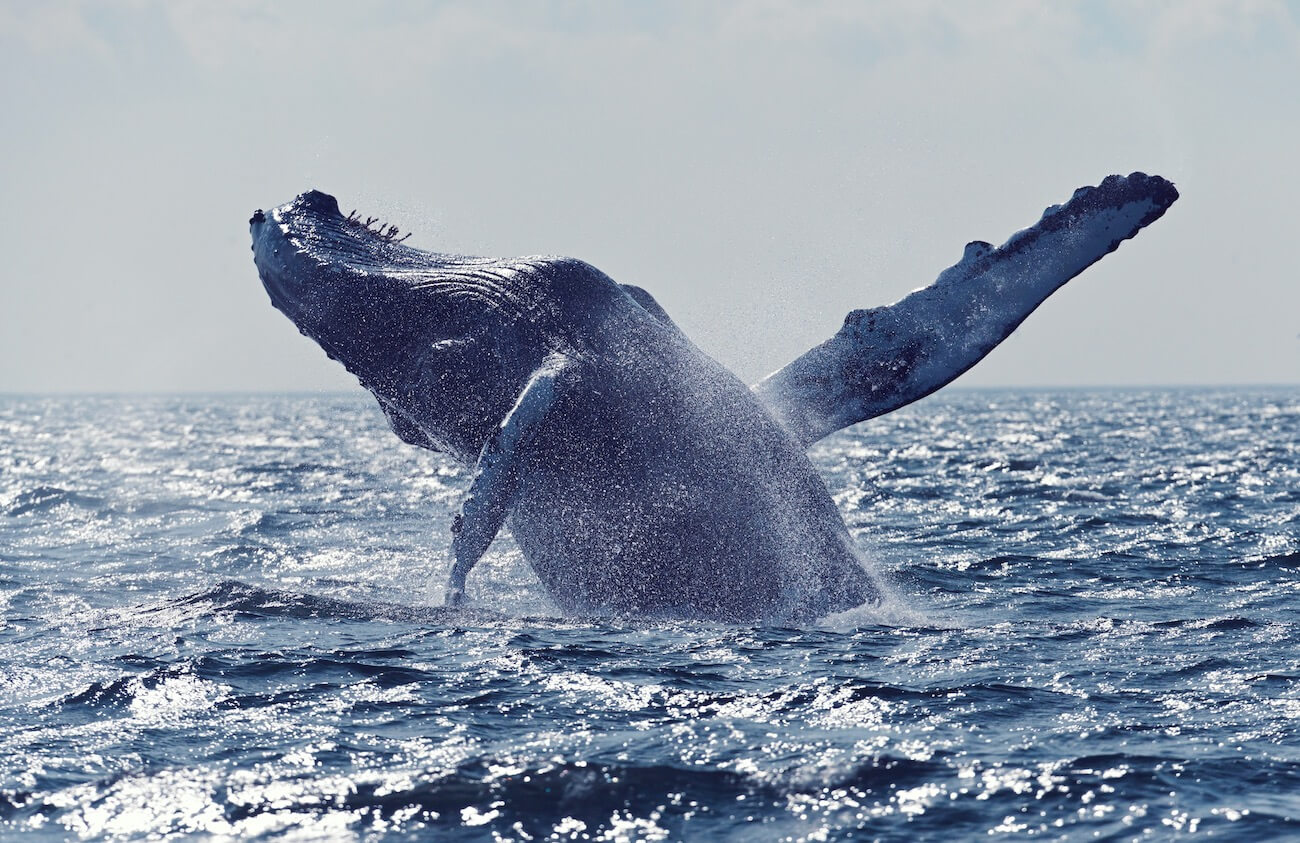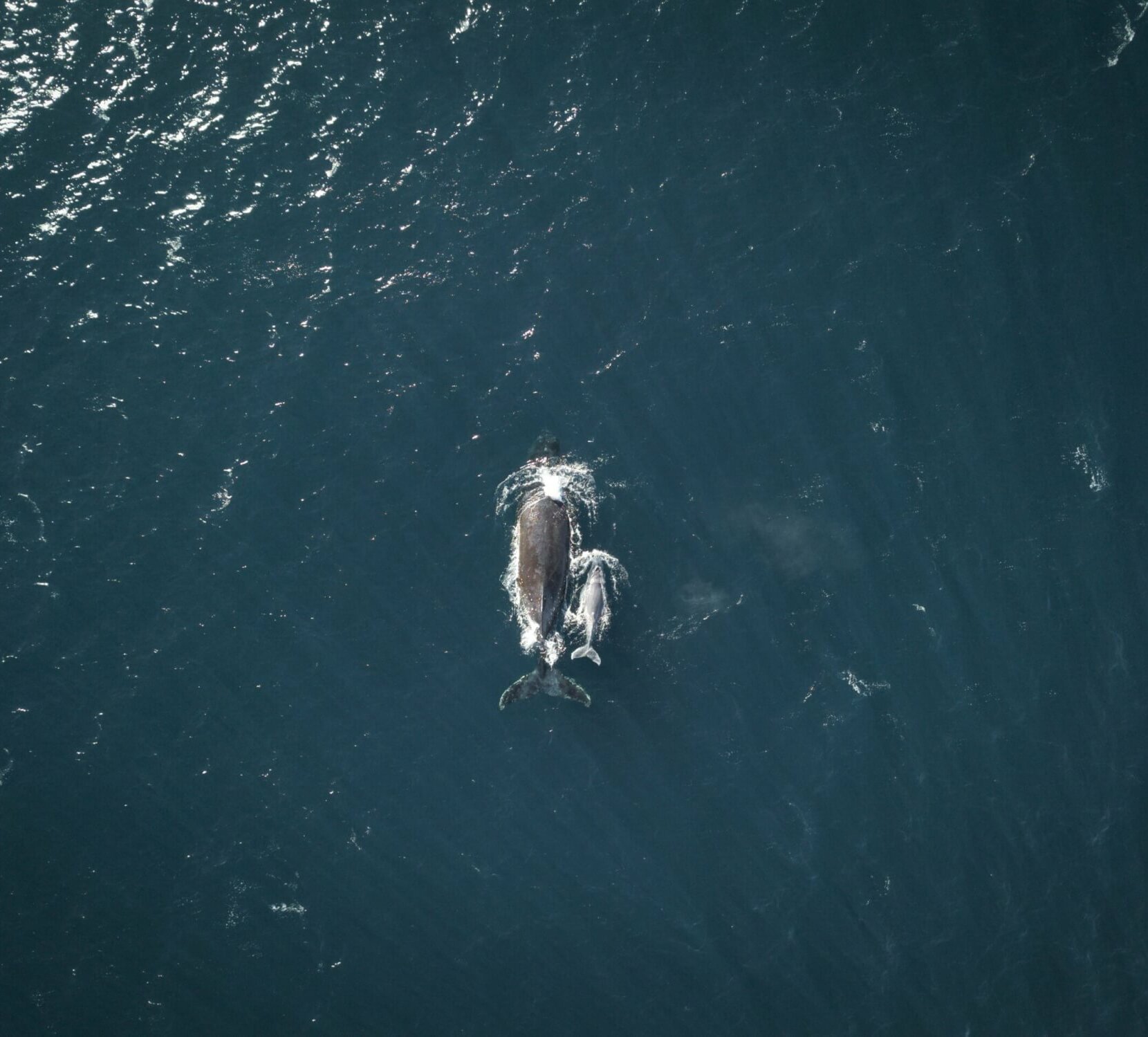A rare behaviour that remains unexplained
Bertie Gregory, explorer for National Geographic, recently witnessed an extremely rare episode of intimidation. While shooting video footage of a pod of Antarctic killer whales attempting to prey on a seal, Gregory was surprised to see a few enormous humpback whales in the vicinity. These cetaceans inserted themselves between the predators and their prey, intimidating the killer whales until they fled. By producing deep, powerful sounds, the baleen whales seemed to want to prevent the killer whales from finishing off their next meal.
Defence techniques
When faced with an imminent attack, any prey has two defence options: fight or flee. For example, whale species in the genus Balenoptera (e.g. fin whales, minke whales and many others) tend to use their exceptional hydrodynamics and unparallelled speed to overwhelm predators when they are attacked.
Humpback whales – the sole representative of the Megaptera genus – tend to opt for combat. Their heavy, plump bodies do not allow them to outswim their predators, so they rely instead on their large tail and powerful pectoral fins to repel them. Measuring over five metres long and weighing at least one tonne each, their pectoral fins – the largest of their kind in the entire cetacean kingdom – give them a remarkable advantage. Flexible, manoeuvrable and equipped with numerous sharp barnacles, these genuine weapons against predators are as unique as they are effective.
A widespread behaviour
Surprisingly, the event filmed earlier this year was not unprecedented. A study published by Marine Mammal Science documents over 115 similar incidents in humpback whale populations around the globe. However, 89% of the prey targeted by killer whales during these interactions were not humpbacks.
The marine mammals that most often fall victim to these cetaceans are pinnipeds (seals, walruses and sea lions), other species of delphinids (porpoises and dolphins) or even the calves of larger whales. Humpback whale calves are frequent victims of killer whale attacks, resulting in a high mortality rate amongst young individuals.
However, humpback whales are the only marine mammals known to willingly approach mammal-eating killer whales and successfully scare them away. Despite the fact that these predators, with their four rows of long, razor-sharp teeth, are formidable adversaries, the humpback whales’ fins allow them to tip the balance of power in their favour. These fins, which are often used against killer whales as defence tools, can cause deep wounds that can later get infected. The predators therefore seem to understand that it is better to remain on the lookout and keep their distance.
Energy implications
According to experts, humpbacks react to killer whale predation vocalizations and intervene to defend the targeted prey even before they know which species is being threatened. This means they likely notice that the victim is not of their own species only after having travelled to the scene, though they generally continue their intervention all the same.
This type of behaviour is detrimental to the whale, however, as it means the animal is interrupting its normal activities (feeding, resting, socializing) and travelling upwards of two or more kilometres to reach the location of the attack. Additionally, their defence is vigorous and aggressive, often lasting more than an hour, and sometimes even up to seven hours!
Not only are the animals distracted from their usual activities, but they consume significant amounts of their preciously accumulated energy defending individuals of other species.
So what’s the point of coming to the aid of other individuals and even more importantly, why maintain the attack to defend individuals of other groups or species?
Hypotheses
Over the years, scientists have formulated a number of hypotheses to try to explain the motives behind the assistance that some humpbacks provide individuals from different groups or even other species – a behaviour rarely observed in the animal kingdom.
As mentioned above, adults are believed to respond to predation calls to defend their own species. Currently, it appears that humpbacks continue to display this behaviour even if the main beneficiaries are other species, since it likely spares enough young calves to justify such a change in their habits.
A first hypothesis is that by approaching the scene of the attack, the humpbacks voluntarily signal their presence so that the killer whales understand that it is not so easy to sneak up on these cetaceans. Although getting into a direct altercation is dangerous, the increased safety that this manoeuvre would provide the calves in the long term likely outweighs the risk that adults face in the heat of the moment.
Additionally, young humpbacks tend to return to the same feeding areas as those frequented by their mothers. Humpback whales from a given region are therefore more likely to be related, which might explain why juveniles benefit from the protection of other adults. From an evolutionary point of view, the purpose of this behaviour is probably to protect the adults’ offspring in order to ensure not only the latter’s survival but at the same time, the transmission of the former’s own genetic material.
Along the same lines, the principle of reciprocity might also explain these unusual situations. This other hypothesis suggests that by helping other members of its population, an individual would have a greater chance of having the favour returned in the future. This behaviour would therefore ensure better odds of survival for all individuals
Lastly, a final hypothesis is frequently raised by the scientific community that attempts to explain this interspecific assistance as a possible form of animal altruism.
Intentional or unintentional altruism, that is the question!
Considering their exceptional intelligence, it would not be surprising if whales voluntarily helped one another. Humpback whales are capable of elaborate thinking, decision-making, problem-solving and sophisticated communication. So why wouldn’t they have the brain power to be intentionally altruistic? Since humpbacks themselves are victims of killer whale predation, could it be possible that they are simply demonstrating a form of empathy toward other members of their species and those of different species that are also hunted by these predators? To this day, these questions remain unanswered.
Learn more
- Whitehead, H., & Glass, C. (1985). Orcas (killer whales) attack humpback whales. Journal of Mammalogy, 66(1), 183-185.









